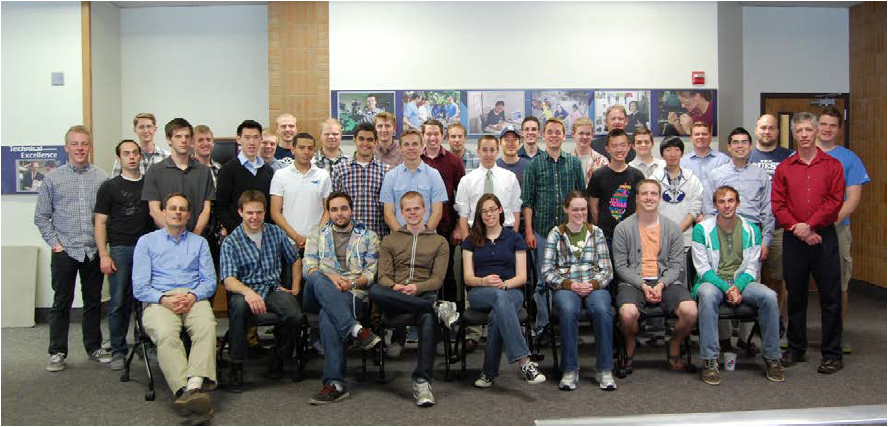Aaron Hawkins and Stephen Schultz, Electrical and Computer Engineering
Project Description
The MEG funds used for this projects supported undergraduate students working in the IMMERSE program starting in the Summer of 2014. IMMERSE employed a total of 35 students, with 14 of them being supervised directly by Dr. Aaron Hawkins and Stephen Schultz. The students working for Drs. Hawkins and Schultz were paid hourly wages for their research work from this MEG grant.

Group Photo showing IMMERSE students and faculty advisors who participated in IMMERSE 2014.
Student participants in IMMERSE 2014:
Jacob Johnson, Trevor Decker, Thomas Townsend, Jeffrey Ravert, John Vogel, Adam Hastings, Ammon Gruwell, Kyle Davidson, Jae Lee, Erik Hamilton, Jared Baxter, Justin Sorensen, Scott Sedgwick, William Lange, Jake Larsen, LeGrand Shumway, Alan Weinert, Luke Hsiao, Carlos Vilorio, Yazan Halawa, Chad Josephson, Matthew Cannon, Matthew Hamblin, Roger Chu, Alex Lin, Luke Newmeyer, Reid Worthen, Rex King, Brittany Irizarry, Katy Dallon, Derek Clement, Andrew Cutler, Danilo Bustamante, Josh Flygare, Nathaniel Gates
Students who were financially supported by this MEG grant: Jacob Johnson, Trevor Decker, Jeffrey Ravert, Erik Hamilton, Jared Baxter, Justin Sorensen, LeGrand Shumway, Alan Weinert, Carlos Vilorio, Chad Josephson, Matthew Hamblin, Roger Chu, Reid Worthen, Rex King
Program Objectives
The three main objectives of the IMMERSE program are: (1) Involving undergraduates in significant, publishable research in the field of electrical and computer engineering (ECE). (2) Improving the ECE infrastructure at BYU through equipment upgrades and on-line documentation. (3) Initiating research in topics that will lead to external funding and greater visibility for BYU.
All students employed by IMMERSE participated in a substantive research project, with the majority of them publishing some type of scientific paper. In addition all students participated in some type of outreach activity or infrastructure improvement. One of the most significant outreach activities undertaken in 2014 was the first Chip Camp. Chip Camp is an engineering day camp designed for 7th and 8th graders. We hosted 60 of these students during 2014 with IMMERSE students acting as camp counselors. Additionally, several research proposals to external funding agencies were written as a direct result of the preliminary research performed by IMMERSE students.
While some papers are still being written based on research work done for the IMMERSE 2014 program, here is a list of publications completed so far which involving IMMERSE Students funded by this MEG Grant (IMMERSE students in bold):
- Carlos Vilorio, Brittany Stark, Aaron R. Hawkins, Kendal Frogget and Brian Jensen, “Stress Relaxation Insensitive Designs for Metal Compliant Mechanism Threshold Accelerometers Metal Switches,” Sensing and Biosensing Research 6, 33-38, (2015).
- Anzi Wang, Sampo Hynynen, Aaron R. Hawkins, Samuel E. Tolley, H. Dennis Tolley, Milton L. Lee, “Axial thermal gradients in microchip gas chromatography,” Journal of Chromatography A 1374, 216-223, (2014).
- Spencer Chadderdon, LeGrand Shumway, Andrew Powell, Ailin Li, Daniel E. Austin, Aaron R. Hawkins, Richard H. Selfridge, Stephen M. Schultz, “Ion Trap Ion trap electric field measurements using slab coupled optical fiber sensors,” Journal of the American Society for Mass Spectrometry 25, 1622-1627, (2014).
- Josh Parks, Hong Cai, Thomas Wall, Matthew Stott, Roger Chu, Erik Hamilton, Aaron Hawkins, Holger Schmidt, “Improvement of Silicon Dioxide Ridge Waveguides Using Low Temperature Thermal Annealing,” CLEO/QELS, San Jose, CA, May 11-15, (2015).
- Daniel Austin, Ailin Li, Aaron Hawkins, Justin Sorensen, Yuan Tian, “Miniaturized Ion Traps,” Pittcon Conference and Expo, New Orleans, LA, March 8-12, (2015).
Mentoring Environment
The mentoring environment used for IMMERSE 2014 consisted of four primary parts: Group meetings, individual meetings, inter-project interactions, and external project interactions.
Group Meetings:
Group meetings were conducted on a weekly basis and consisted of four to seven faculty and all of the involved students. These meetings allow edfaculty members to give training on general research methods and oral and written communication. The following are a list of topics presented by faculty members: a) How to give a technical oral presentation b) How and where 3 to publish a paper c) How to assemble and write a technical paper d) How to find and use reference articles e) Applying to graduate school f) Applying for fellowships g) Engineering ethics h) Is graduate school right for you i) Formulating webpages for maximum impact.
Each student gave a technical presentation in this meeting which provided a supportive atmosphere consisting mostly of their peers, helping them to develop better communications skills and put their specific research into a “big picture” context.
Individual Meetings:
The student research topics were divided between faculty members. Faculty held individual meetings at least once a week with the students involved in the subtopics. These meetings included progress reports given by each of the students involved.
Interproject Interaction:
All of the students supported by this MEG grant were working on research projects which involved microfabrication processes or photonics systems. Thus, the individual subtopics had a great deal of overlap. This overlap fostered interaction between the students working on the individual projects. This student interaction provided mentoring between the students. This interaction also helped the students learn to work in teams to solve technical problems.
External Project Interaction:
This mentoring environment also fostered relationships between undergraduate students working on these projects and graduate students working on related projects. This relationship encourages the transfer of expertise from the graduate students to the undergraduate students and vice versa.
Funds Spent
All of the $20,000 awarded by this grant went to student wages for undergraduate researchers.
